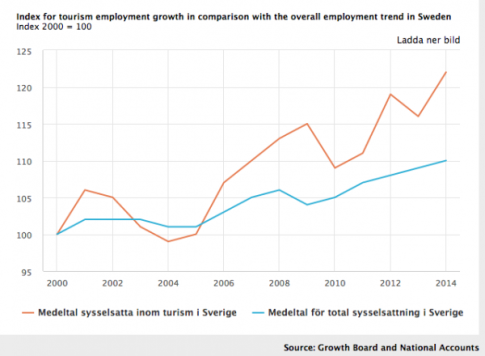(Astrid Lindgren is running short on accommodations – its guest house and hostel will house refugees this summer)
“Whichever way we slice the data, the growth in working age population stands out as a key driver of economic growth for most countries. A healthy dependency ratio, a skilled workforce, together with strong institutions and an absence of major resource imbalances is usually the formula for country-level success. But with most DMs weighed down by ageing populations, a key question is this – can people inflows counter challenging demographics? The short answer is yes.”
That’s what Goldman said last autumn as Europe’s refugee crisis began to spiral out of control. We’re not sure if it had occurred to the bank just how large the people flows into Western Europe would end up being because the implication in the excerpted passage above is that the influx of people may actually be a good thing economically speaking if it ameliorates negative demographic shifts.
Of course Goldman may be proven right in the long-run, but in the short-term the mass migration is straining Western Europe’s resources and now looks set to drive up the unemployment rate in Germany.
“German joblessness was unchanged in March, snapping a run of five consecutive declines, in a sign that Europe’s largest economy may be struggling to absorb a wave of refugees,” Bloomberg wrote, earlier today, adding that “Germany admitted more than 1 million migrants in 2015 alone [which] increased the pool of potential workers.”
A new report from Berlin’s labor agency suggests that it will likely be years before the country experiences any benefit from the migration wave. “It can be expected that the labor supply will expand because of migration and the number of unemployed refugees will rise,” as it will take time for migrants to master the language and obtain the qualifications they’ll need to join the labor force.
Meanwhile, in Sweden, the toursim industry is being choked off by the migrant flows. According to SvD Naringsliv, the Swedish Migration Board’s move to transform tourist facilities into asylum centers means they’ll be no more room for vacationers – literally.
“In some municipalities, there will be no hotel beds at all,” Lena Larsson, CEO at Smaland Tourism said. Here’s more (Google translated):
For example, expected the large visiting goal Astrid Lindgren stand without quality accommodation when both the guest house and hostel continues to be asylum facilities in the summer.
The players in the tourism industry looks understood the seriousness of the background of the war in Syria, but several highlights that the consequences of the Migration Board’s procurement for the tourism industry in Sweden “must be clarified.”
It is so big changes to Visit Småland now has to scan the entire range. It is very uncertain how it will be this summer, says Lena Karlsson.
Another example can be found on the west coast. There, says Lars-Eric Fields, president of Södra Bohuslän tourism, the impact on summer tourism is likely to be so big that you have to take stock of the range of partners throughout western Sweden. According Fields also affected touristic prime locations, which Socialite House “Batellet” on the island of Marstrand and city hotel in Lysekil which are both refugee accommodations in the summer.
Another sample can be collected by Vänern. Where does the Migration Board’s shops to tourist nights in the spa town Lundsbrunn replaced by 870 asylum places, which admittedly can quickly raise the plant’s own turnover to about SEK 100 million per year, but which also affects the district’s normal tourism. Clearly, fewer tourist beds provide less surface for ancillary tourism – for example from Tarnaby mountain village reported that the chairlift can no longer be operated for lack of tourist beds.
The situation is thus similar in many areas. Oland Tourism says, however, that all cabin accommodation falls away in the summer, as Boda Baden, Mölltorp and Littorinabyn.
Uncertainty about the summer tourism is also noticeable in the Swedish Tourist Association where 15 hostels during the winter has served as places of asylum, including Farosund. Now in the end requires the STF decision from the franchisees if they remain in the tourism or remain
Immigration Service asylum accommodation. One who decided Maria Karlsson, who owns the hostel in Skåne Hammenhög where the resort now count to five asylum accommodation.
So there you have it, folks. An industry that brings in around $32 billion per year (and that doesn’t count the $12 billion tourists spend on food, entertainment, and transportation) is about to disappear entirely thanks to the housing needs of Mid-East migrants.
If you want to get a good idea of just how important tourism is to Sweden’s economy, have a look at the following graph which shows employment growth in tourism versus the overall labor market trend:
And here is the final insult: Sweden’s toursim industry employs around 160,000 people. The number of refugees Sweden took in from the Mid-East in 2015 was… drumroll… 160,000.


